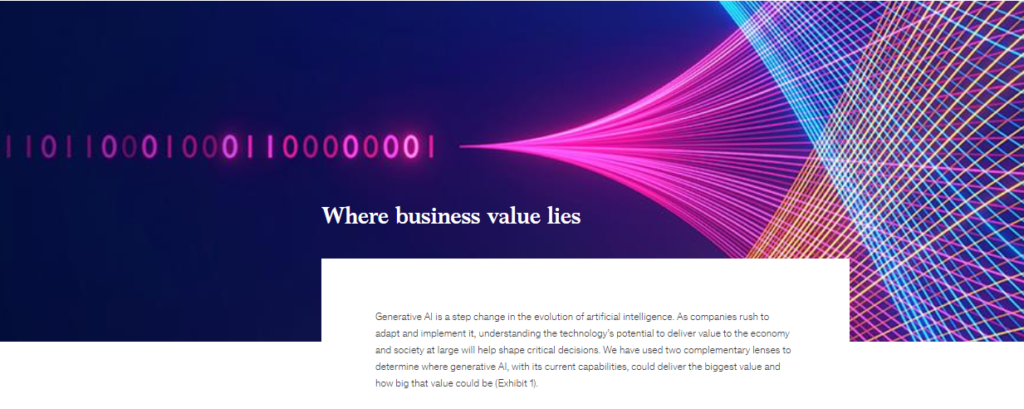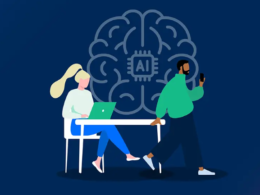the health strategist
knowledge platform
health management strategy, engineering, and technology
for continuous transformation
Joaquim Cardoso MSc.
Chief Research Officer (CSO), Chief Editor
Chief Strategy Officer (CSO) and Senior Advisor
August 4, 2023
What is the message?
Generative AI is a step change in the evolution of artificial intelligence. As companies rush to adapt and implement it, understanding the technology’s potential to deliver value to the economy and society at large will help shape critical decisions.
Key takeaways:
- The field of generative AI is evolving rapidly and holds great promise for creativity and innovation. However, traditional AI applications still dominate the overall potential value of AI, particularly in numerical and optimization tasks like predictive modeling. Despite this, generative AI is opening new frontiers and expanding the possibilities of what AI can achieve.
- An analysis of 16 business functions revealed that generative AI could have a significant impact on several key areas, including customer operations, marketing and sales, software engineering, and research and development. These functions have the potential to account for approximately 75 percent of the total annual value generated from generative AI use cases.
- Interestingly, some functions that were prominent in previous AI use cases, such as manufacturing and supply chain, now hold lower potential value due to the exclusion of numerical and optimization applications in generative AI use cases.
- Beyond function-specific use cases, generative AI could revolutionize internal knowledge management systems within organizations. With its natural-language processing capabilities, generative AI can help employees access relevant information quickly by formulating queries in human-like language and engaging in ongoing dialogue. This can lead to better-informed decisions and effective strategies.
- According to a 2012 McKinsey Global Institute (MGI) estimate, knowledge workers spent a significant portion of their time searching for and gathering information. If generative AI can take on such tasks, it could greatly increase the efficiency and effectiveness of workers, resulting in substantial benefits.
- Generative AI’s ability to “read” vast libraries of corporate information and collaborate with humans to fine-tune research offers a more scalable solution than relying on a team of human experts.
- Additionally, generative AI can work in partnership with employees, accelerating productivity by quickly analyzing vast amounts of data and providing valuable insights and options for knowledge work.
- In conclusion, while generative AI presents exciting opportunities for creativity and innovation, traditional AI applications continue to hold the majority of the overall potential value of AI. However, generative AI’s significant impact on key business functions and its potential to revolutionize internal knowledge management systems make it a technology worthy of attention and investment. By leveraging generative AI, organizations can unlock new sources of value and enhance productivity across various business domains.
Infographics:
Two complementary lenses have been used to determine where generative AI, with its current capabilities, could deliver the biggest value and how big that value could be (Exhibit 1).



DEEP DIVE

Where business value lies [Generative AI – Part 2]
This is an excerpt of the report “The state of AI in 2023: Generative AI’s breakout year”, published by MGI (McKinsey Global Institute), authored by Michael Chui, Lareina Yee; Bryce Hall, Alex Singla and Alexander Sukharevsky, an issued on August, 2023.
MGI
Michael Chui, Eric Hazan, Roger Roberts, Alex Singla, Kate Smaje, Alex Sukharevsky, Lareina Yee, and Rodney Zemmel
June 14, 2023
Generative AI is a step change in the evolution of artificial intelligence. As companies rush to adapt and implement it, understanding the technology’s potential to deliver value to the economy and society at large will help shape critical decisions. We have used two complementary lenses to determine where generative AI, with its current capabilities, could deliver the biggest value and how big that value could be (Exhibit 1).
Exhibit 1

The first lens scans use cases for generative AI that organizations could adopt. We define a “use case” as a targeted application of generative AI to a specific business challenge, resulting in one or more measurable outcomes. For example, a use case in marketing is the application of generative AI to generate creative content such as personalized emails, the measurable outcomes of which potentially include reductions in the cost of generating such content and increases in revenue from the enhanced effectiveness of higher-quality content at scale. We identified 63 generative AI use cases spanning 16 business functions that could deliver total value in the range of $2.6 trillion to $4.4 trillion in economic benefits annually when applied across industries.
That would add 15 to 40 percent to the $11 trillion to $17.7 trillion of economic value that we now estimate nongenerative artificial intelligence and analytics could unlock. (Our previous estimate from 2017 was that AI could deliver $9.5 trillion to $15.4 trillion in economic value.)
Our second lens complements the first by analyzing generative AI’s potential impact on the work activities required in some 850 occupations. We modeled scenarios to estimate when generative AI could perform each of more than 2,100 “detailed work activities”—such as “communicating with others about operational plans or activities”—that make up those occupations across the world economy. This enables us to estimate how the current capabilities of generative AI could affect labor productivity across all work currently done by the global workforce.
Some of this impact will overlap with cost reductions in the use case analysis described above, which we assume are the result of improved labor productivity. Netting out this overlap, the total economic benefits of generative AI—including the major use cases we explored and the myriad increases in productivity that are likely to materialize when the technology is applied across knowledge workers’ activities—amounts to $6.1 trillion to $7.9 trillion annually (Exhibit 2).
Exhibit 2

While generative AI is an exciting and rapidly advancing technology, the other applications of AI discussed in our previous report continue to account for the majority of the overall potential value of AI. Traditional advanced-analytics and machine learning algorithms are highly effective at performing numerical and optimization tasks such as predictive modeling, and they continue to find new applications in a wide range of industries. However, as generative AI continues to develop and mature, it has the potential to open wholly new frontiers in creativity and innovation. It has already expanded the possibilities of what AI overall can achieve (see sidebar “How we estimated the value potential of generative AI use cases”).
In this section, we highlight the value potential of generative AI across business functions.
Generative AI could have an impact on most business functions; however, a few stand out when measured by the technology’s impact as a share of functional cost (Exhibit 3). Our analysis of 16 business functions identified just four—customer operations, marketing and sales, software engineering, and research and development—that could account for approximately 75 percent of the total annual value from generative AI use cases.
Exhibit 3

Notably, the potential value of using generative AI for several functions that were prominent in our previous sizing of AI use cases, including manufacturing and supply chain functions, is now much lower.5 This is largely explained by the nature of generative AI use cases, which exclude most of the numerical and optimization applications that were the main value drivers for previous applications of AI.
In addition to the potential value generative AI can deliver in function-specific use cases, the technology could drive value across an entire organization by revolutionizing internal knowledge management systems. Generative AI’s impressive command of natural-language processing can help employees retrieve stored internal knowledge by formulating queries in the same way they might ask a human a question and engage in continuing dialogue. This could empower teams to quickly access relevant information, enabling them to rapidly make better-informed decisions and develop effective strategies.
In 2012, the McKinsey Global Institute (MGI) estimated that knowledge workers spent about a fifth of their time, or one day each work week, searching for and gathering information. If generative AI could take on such tasks, increasing the efficiency and effectiveness of the workers doing them, the benefits would be huge. Such virtual expertise could rapidly “read” vast libraries of corporate information stored in natural language and quickly scan source material in dialogue with a human who helps fine-tune and tailor its research, a more scalable solution than hiring a team of human experts for the task.
In other cases, generative AI can drive value by working in partnership with workers, augmenting their work in ways that accelerate their productivity. Its ability to rapidly digest mountains of data and draw conclusions from it enables the technology to offer insights and options that can dramatically enhance knowledge work. This can significantly speed up the process of developing a product and allow employees to devote more time to higher-impact tasks.
Following are four examples of how generative AI could produce operational benefits in a handful of use cases across the business functions that could deliver a majority of the potential value we identified in our analysis of 63 generative AI use cases. In the first two examples, it serves as a virtual expert, while in the following two, it lends a hand as a virtual collaborator.
How we estimated the value potential of generative AI use cases
To assess the potential value of generative AI, we updated a proprietary McKinsey database of potential AI use cases and drew on the experience of more than 100 experts in industries and their business functions.
Our updates examined use cases of generative AI—specifically, how generative AI techniques (primarily transformer-based neural networks) can be used to solve problems not well addressed by previous technologies.
We analyzed only use cases for which generative AI could deliver a significant improvement in the outputs that drive key value. In particular, our estimates of the primary value the technology could unlock do not include use cases for which the sole benefit would be its ability to use natural language. For example, natural-language capabilities would be the key driver of value in a customer service use case but not in a use case optimizing a logistics network, where value primarily arises from quantitative analysis.
We then estimated the potential annual value of these generative AI use cases if they were adopted across the entire economy. For use cases aimed at increasing revenue, such as some of those in sales and marketing, we estimated the economy-wide value generative AI could deliver by increasing the productivity of sales and marketing expenditures.
Our estimates are based on the structure of the global economy in 2022 and do not consider the value generative AI could create if it produced entirely new product or service categories.
Customer operations: Improving customer and agent experiences

Generative AI has the potential to revolutionize the entire customer operations function, improving the customer experience and agent productivity through digital self-service and enhancing and augmenting agent skills. The technology has already gained traction in customer service because of its ability to automate interactions with customers using natural language. Research found that at one company with 5,000 customer service agents, the application of generative AI increased issue resolution by 14 percent an hour and reduced the time spent handling an issue by 9 percent.1 It also reduced agent attrition and requests to speak to a manager by 25 percent. Crucially, productivity and quality of service improved most among less-experienced agents, while the AI assistant did not increase—and sometimes decreased—the productivity and quality metrics of more highly skilled agents. This is because AI assistance helped less-experienced agents communicate using techniques similar to those of their higher-skilled counterparts.
The following are examples of the operational improvements generative AI can have for specific use cases:
- Customer self-service. Generative AI–fueled chatbots can give immediate and personalized responses to complex customer inquiries regardless of the language or location of the customer. By improving the quality and effectiveness of interactions via automated channels, generative AI could automate responses to a higher percentage of customer inquiries, enabling customer care teams to take on inquiries that can only be resolved by a human agent. Our research found that roughly half of customer contacts made by banking, telecommunications, and utilities companies in North America are already handled by machines, including but not exclusively AI. We estimate that generative AI could further reduce the volume of human-serviced contacts by up to 50 percent, depending on a company’s existing level of automation.
- Resolution during initial contact. Generative AI can instantly retrieve data a company has on a specific customer, which can help a human customer service representative more successfully answer questions and resolve issues during an initial interaction.
- Reduced response time. Generative AI can cut the time a human sales representative spends responding to a customer by providing assistance in real time and recommending next steps.
- Increased sales. Because of its ability to rapidly process data on customers and their browsing histories, the technology can identify product suggestions and deals tailored to customer preferences. Additionally, generative AI can enhance quality assurance and coaching by gathering insights from customer conversations, determining what could be done better, and coaching agents.
We estimate that applying generative AI to customer care functions could increase productivity at a value ranging from 30 to 45 percent of current function costs.
Our analysis captures only the direct impact generative AI might have on the productivity of customer operations. It does not account for potential knock-on effects the technology may have on customer satisfaction and retention arising from an improved experience, including better understanding of the customer’s context that can assist human agents in providing more personalized help and recommendations.
Marketing and sales: Boosting personalization, content creation, and sales productivity

Generative AI has taken hold rapidly in marketing and sales functions, in which text-based communications and personalization at scale are driving forces. The technology can create personalized messages tailored to individual customer interests, preferences, and behaviors, as well as do tasks such as producing first drafts of brand advertising, headlines, slogans, social media posts, and product descriptions.
Marketing
Introducing generative AI to marketing functions requires careful consideration. For one thing, mathematical models trained on publicly available data without sufficient safeguards against plagiarism, copyright violations, and branding recognition risks infringing on intellectual property rights. A virtual try-on application may produce biased representations of certain demographics because of limited or biased training data. Thus, significant human oversight is required for conceptual and strategic thinking specific to each company’s needs.
Potential operational benefits from using generative AI for marketing include the following:
- Efficient and effective content creation. Generative AI could significantly reduce the time required for ideation and content drafting, saving valuable time and effort. It can also facilitate consistency across different pieces of content, ensuring a uniform brand voice, writing style, and format. Team members can collaborate via generative AI, which can integrate their ideas into a single cohesive piece. This would allow teams to significantly enhance personalization of marketing messages aimed at different customer segments, geographies, and demographics. Mass email campaigns can be instantly translated into as many languages as needed, with different imagery and messaging depending on the audience. Generative AI’s ability to produce content with varying specifications could increase customer value, attraction, conversion, and retention over a lifetime and at a scale beyond what is currently possible through traditional techniques.
- Enhanced use of data. Generative AI could help marketing functions overcome the challenges of unstructured, inconsistent, and disconnected data—for example, from different databases—by interpreting abstract data sources such as text, image, and varying structures. It can help marketers better use data such as territory performance, synthesized customer feedback, and customer behavior to generate data-informed marketing strategies such as targeted customer profiles and channel recommendations. Such tools could identify and synthesize trends, key drivers, and market and product opportunities from unstructured data such as social media, news, academic research, and customer feedback.
- SEO optimization. Generative AI can help marketers achieve higher conversion and lower cost through search engine optimization (SEO) for marketing and sales technical components such as page titles, image tags, and URLs. It can synthesize key SEO tokens, support specialists in SEO digital content creation, and distribute targeted content to customers.
- Product discovery and search personalization. With generative AI, product discovery and search can be personalized with multimodal inputs from text, images, and speech, and a deep understanding of customer profiles. For example, technology can leverage individual user preferences, behavior, and purchase history to help customers discover the most relevant products and generate personalized product descriptions. This would allow CPG, travel, and retail companies to improve their e-commerce sales by achieving higher website conversion rates.
We estimate that generative AI could increase the productivity of the marketing function with a value between 5 and 15 percent of total marketing spending.
Our analysis of the potential use of generative AI in marketing doesn’t account for knock-on effects beyond the direct impacts on productivity. Generative AI–enabled synthesis could provide higher-quality data insights, leading to new ideas for marketing campaigns and better-targeted customer segments. Marketing functions could shift resources to producing higher-quality content for owned channels, potentially reducing spending on external channels and agencies.
Sales
Generative AI could also change the way both B2B and B2C companies approach sales. The following are two use cases for sales:
- Increase probability of sale. Generative AI could identify and prioritize sales leads by creating comprehensive consumer profiles from structured and unstructured data and suggesting actions to staff to improve client engagement at every point of contact. For example, generative AI could provide better information about client preferences, potentially improving close rates.
- Improve lead development. Generative AI could help sales representatives nurture leads by synthesizing relevant product sales information and customer profiles and creating discussion scripts to facilitate customer conversation, including up- and cross-selling talking points. It could also automate sales follow-ups and passively nurture leads until clients are ready for direct interaction with a human sales agent.
Our analysis suggests that implementing generative AI could increase sales productivity by approximately 3 to 5 percent of current global sales expenditures.
This analysis may not fully account for additional revenue that generative AI could bring to sales functions. For instance, generative AI’s ability to identify leads and follow-up capabilities could uncover new leads and facilitate more effective outreach that would bring in additional revenue. Also, the time saved by sales representatives due to generative AI’s capabilities could be invested in higher-quality customer interactions, resulting in increased sales success.
Software engineering: Speeding developer work as a coding assistant

Treating computer languages as just another language opens new possibilities for software engineering. Software engineers can use generative AI in pair programming and to do augmented coding and train LLMs to develop applications that generate code when given a natural-language prompt describing what that code should do.
Software engineering is a significant function in most companies, and it continues to grow as all large companies, not just tech titans, embed software in a wide array of products and services. For example, much of the value of new vehicles comes from digital features such as adaptive cruise control, parking assistance, and IoT connectivity.
According to our analysis, the direct impact of AI on the productivity of software engineering could range from 20 to 45 percent of current annual spending on the function. This value would arise primarily from reducing time spent on certain activities, such as generating initial code drafts, code correction and refactoring, root-cause analysis, and generating new system designs. By accelerating the coding process, generative AI could push the skill sets and capabilities needed in software engineering toward code and architecture design. One study found that software developers using Microsoft’s GitHub Copilot completed tasks 56 percent faster than those not using the tool.1 An internal McKinsey empirical study of software engineering teams found those who were trained to use generative AI tools rapidly reduced the time needed to generate and refactor code—and engineers also reported a better work experience, citing improvements in happiness, flow, and fulfillment.
Our analysis did not account for the increase in application quality and the resulting boost in productivity that generative AI could bring by improving code or enhancing IT architecture—which can improve productivity across the IT value chain. However, the quality of IT architecture still largely depends on software architects, rather than on initial drafts that generative AI’s current capabilities allow it to produce.
Large technology companies are already selling generative AI for software engineering, including GitHub Copilot, which is now integrated with OpenAI’s GPT-4, and Replit, used by more than 20 million coders.
Product R&D: Reducing research and design time, improving simulation and testing

Generative AI’s potential in R&D is perhaps less well recognized than its potential in other business functions. Still, our research indicates the technology could deliver productivity with a value ranging from 10 to 15 percent of overall R&D costs.
For example, the life sciences and chemical industries have begun using generative AI foundation models in their R&D for what is known as generative design. Foundation models can generate candidate molecules, accelerating the process of developing new drugs and materials. Entos, a biotech pharmaceutical company, has paired generative AI with automated synthetic development tools to design small-molecule therapeutics. But the same principles can be applied to the design of many other products, including larger-scale physical products and electrical circuits, among others.
While other generative design techniques have already unlocked some of the potential to apply AI in R&D, their cost and data requirements, such as the use of “traditional” machine learning, can limit their application. Pretrained foundation models that underpin generative AI, or models that have been enhanced with fine-tuning, have much broader areas of application than models optimized for a single task. They can therefore accelerate time to market and broaden the types of products to which generative design can be applied. For now, however, foundation models lack the capabilities to help design products across all industries.
In addition to the productivity gains that result from being able to quickly produce candidate designs, generative design can also enable improvements in the designs themselves, as in the following examples of the operational improvements generative AI could bring:
- Enhanced design. Generative AI can help product designers reduce costs by selecting and using materials more efficiently. It can also optimize designs for manufacturing, which can lead to cost reductions in logistics and production.
- Improved product testing and quality. Using generative AI in generative design can produce a higher-quality product, resulting in increased attractiveness and market appeal. Generative AI can help to reduce testing time of complex systems and accelerate trial phases involving customer testing through its ability to draft scenarios and profile testing candidates.
We also identified a new R&D use case for nongenerative AI: deep learning surrogates, the use of which has grown since our earlier research, can be paired with generative AI to produce even greater benefits. To be sure, integration will require the development of specific solutions, but the value could be significant because deep learning surrogates have the potential to accelerate the testing of designs proposed by generative AI.
While we have estimated the potential direct impacts of generative AI on the R&D function, we did not attempt to estimate the technology’s potential to create entirely novel product categories. These are the types of innovations that can produce step changes not only in the performance of individual companies but in economic growth overall.
Originally published at https://www.mckinsey.com/capabilities/mckinsey-digital












